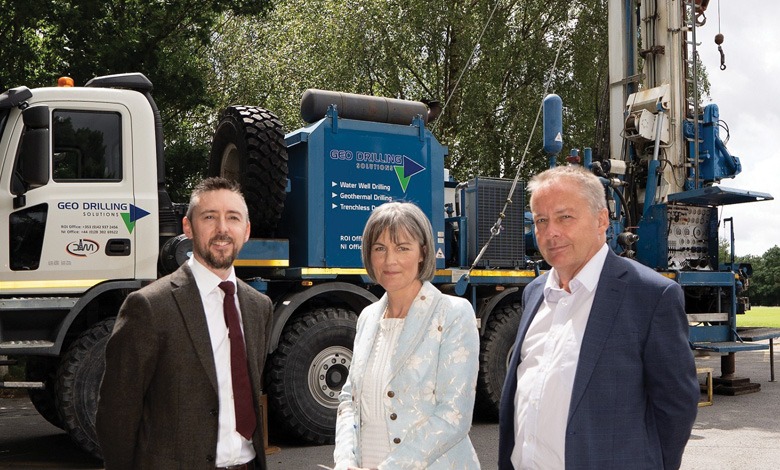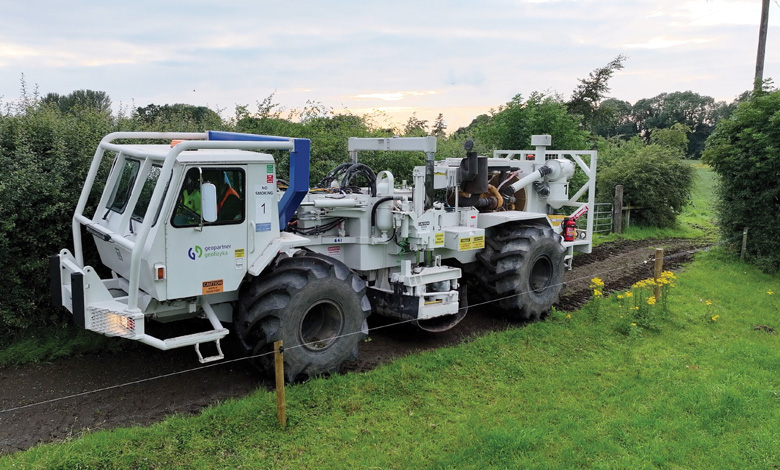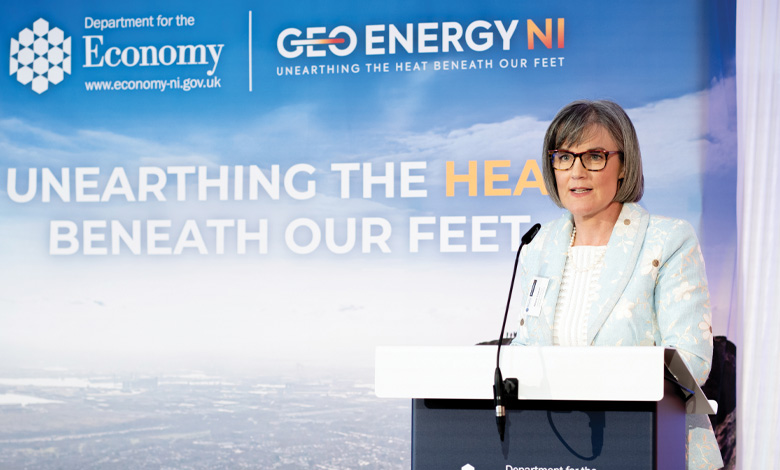Unearthing the heat beneath our feet

This summer, the Department for the Economy (DfE), with scientific support from our team at the Geological Survey of Northern Ireland (GSNI), launched a multimillion-pound project to explore the potential for geothermal energy in Northern Ireland.
The GeoEnergy NI project, involving a specialist contractor team led by Tetra Tech Europe, will conduct shallow and deep geothermal feasibility studies in two Northern Ireland locations – the Stormont Estate in Belfast and the College of Agriculture, Food and Rural Enterprise (CAFRE) Greenmount Campus near Antrim. Designed to ‘unearth the heat beneath our feet’, GeoEnergy NI is a strategic and exciting part of the DfE’s Energy Strategy Action Plan 2022, recognising the importance of having a secure, affordable, and low carbon energy source now and into the future, and a key element of the Path to Net Zero Energy strategy.
Harnessing our potential
In Northern Ireland, we are fortunate to have such diverse geology, with significant untapped potential for geothermal energy. While there are a small number of innovative non-domestic installations such as the Queen’s University Belfast (QUB) Riddel Hall, McClay, and Biosciences buildings, and domestic applications in operation today, geothermal is very much an underutilised source of energy locally.
Through this project, we aim to prove the potential for geothermal energy within Northern Ireland, allowing us to further explore the possibilities of harnessing this renewable energy source and, in turn, encourage future private sector investment in this important technology across the region.
Geothermal energy brings with it a host of economic, environmental, and social benefits. Through GeoEnergy NI, we can help inform the development of policy and regulatory frameworks that support and promote a vibrant geothermal sector. With that comes the potential for high-value jobs and skills created through direct employment and spin-off industries. In Germany for example, where there is a growing geothermal industry, the sector has created around 22,000 jobs and provided an economic stimulus of €13.3 billion since 2000 (BMWi data). Geothermal can also significantly contribute to net zero goals by potentially delivering savings of between 2,400 to 14,000 tonnes of equivalent CO2 emissions per year (DSNZ white paper, July 2023).
Powering ahead
Having officially launched in June 2023, we are proud to report that the GeoEnergy NI project has progressed at pace and has already reached a significant number of key milestones.
A project website – GeoEnergyNI.org – has been established, packed full of useful information on geothermal energy, its benefits and project news. Those interested can also keep up to date through our Facebook, X, and LinkedIn social media channels. Together with partners and private and public sector organisations, we created a series of videos and an animation to help demystify and explain geothermal energy, showcasing some places where it is already being utilised in Northern Ireland. We are grateful to the teams at Girdwood Community Hub, the Giant’s Causeway, and QUB Business School for explaining their geothermal energy building projects and bringing its benefits to life.
Rolling in the deep
July 2023 was an exciting time for the project as we completed exploratory geophysical surveys around CAFRE. Working together with our sub-contractor GeoPartner, we were on location for under two weeks and, in that time, we successfully completed a wide range of gravity, magnetotelluric, and seismic surveys to explore the potential for deep geothermal energy within County Antrim. We are incredibly grateful to local residents and landowners for their support, and to CAFRE for facilitating this survey activity and helping its smooth delivery.

We will now move to the data processing and interpretation stage of this work, using the data collected to develop a 3D geological model of the underground geology to a depth of approximately 2 kilometres, providing us with valuable insight into the type of geology around County Antrim. This can then be used to assess the geothermal heat potential at the Greenmount Campus and provide information on the suitability for future low-carbon sustainable heat in the wider Antrim area, enabling the possibility of a geothermally powered district heating network.

On the horizon
Of course, this is only one part of the GeoEnergy NI project, and we will also be investigating potential drill sites on the Stormont Estate, Belfast. This aspect of the project aims to identify the most suitable geothermal solution to provide future heating and cooling for several pre-identified buildings on the Estate. Five locations for shallow boreholes have been identified within the Stormont Estate and it is hoped one borehole location will be accessible for public viewing for those who wish to learn more about geothermal energy.
Through GeoEnergy NI, we want to showcase geothermal energy to help increase public awareness and support, as well as encourage future investment opportunities. As part of this outreach, we will be opening a mobile visitor centre in the coming months, fully equipped with a range of educational resources including virtual reality headsets to help explain the geothermal energy. Initially, it will be situated on the Stormont Estate, and we plan to visit schools and locations across Northern Ireland in the months ahead. It is important to us to engage with local communities as well as our next generation of scientists and leaders who are critical on our journey towards net-zero and beyond.
A sustainable future
By unearthing the geothermal resources beneath our feet, GeoEnergy NI will help pave the way for a more sustainable energy future – a future powered by the planet itself. As we continue to gather data, results and roll out the project, we will fine-tune our understanding of the availability of geothermal energy and better utilise this locally available, cost-effective, renewable, and low-carbon resource for the benefit of all.

To find out more about geothermal energy and to keep up to date with the GeoEnergy NI project visit www.GeoEnergyNI.org





